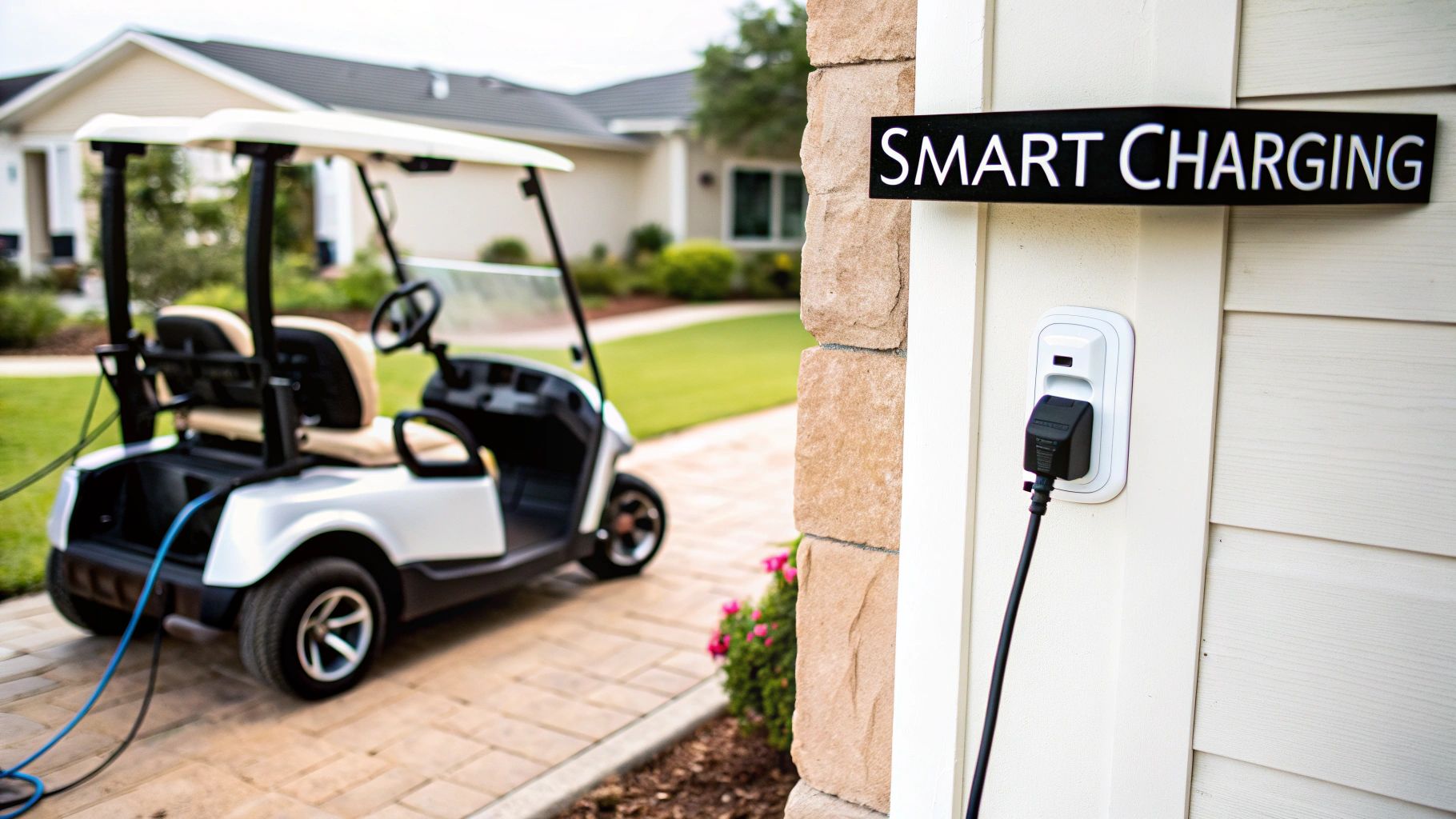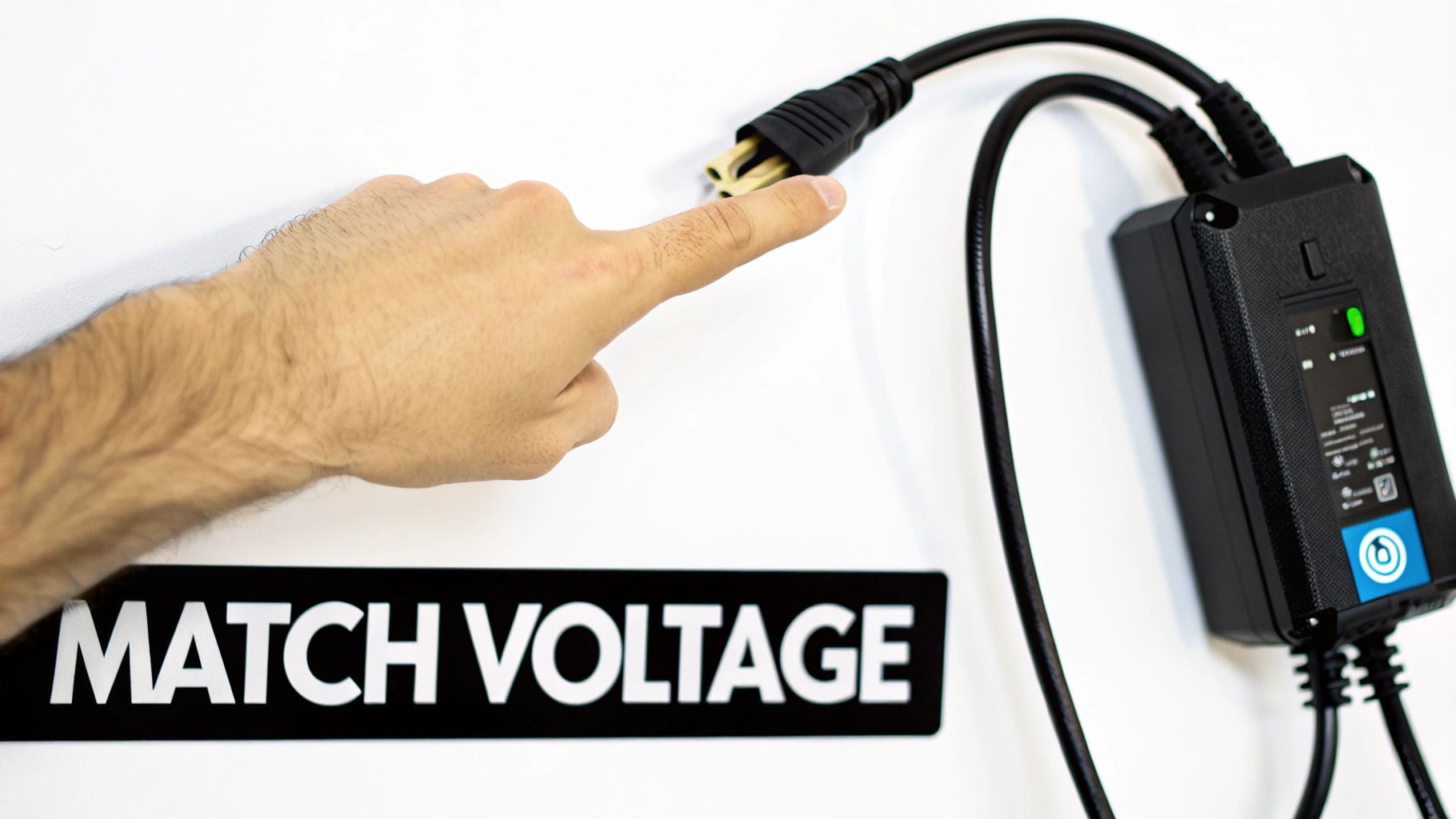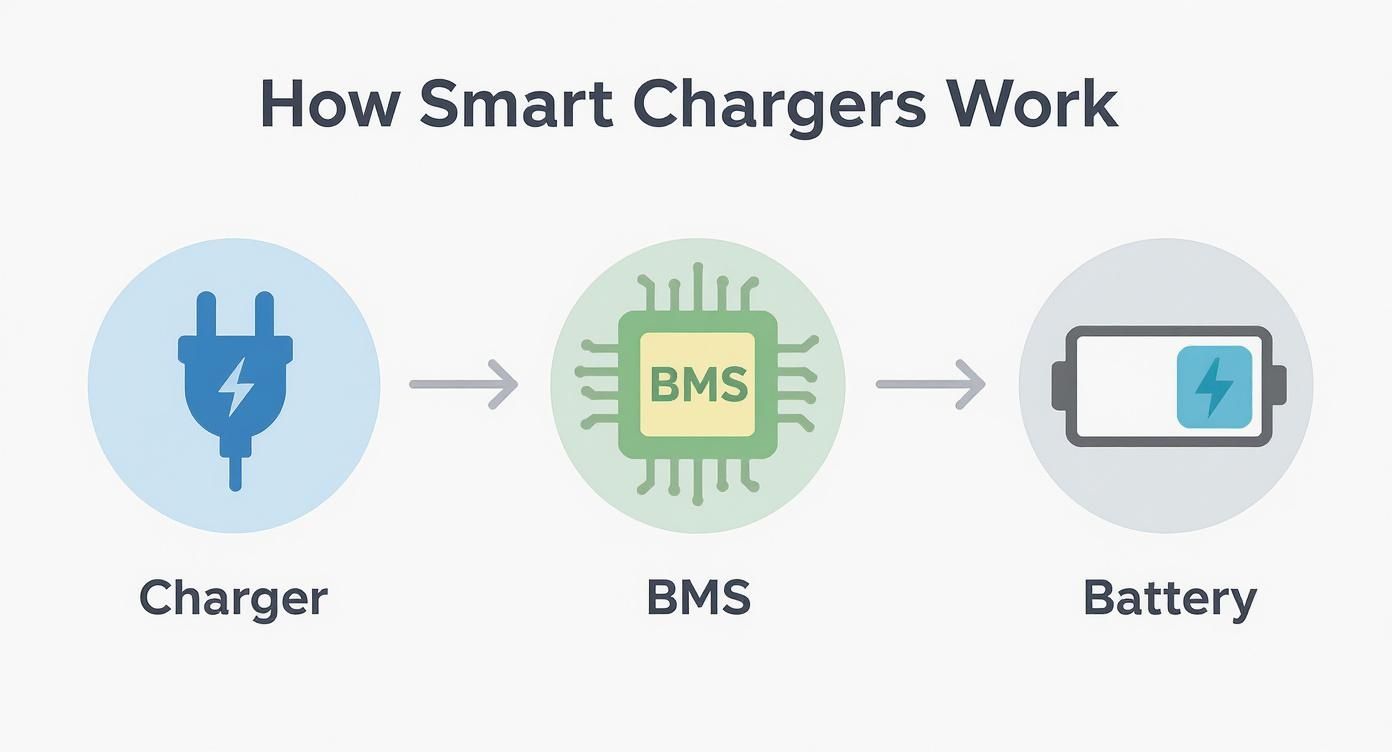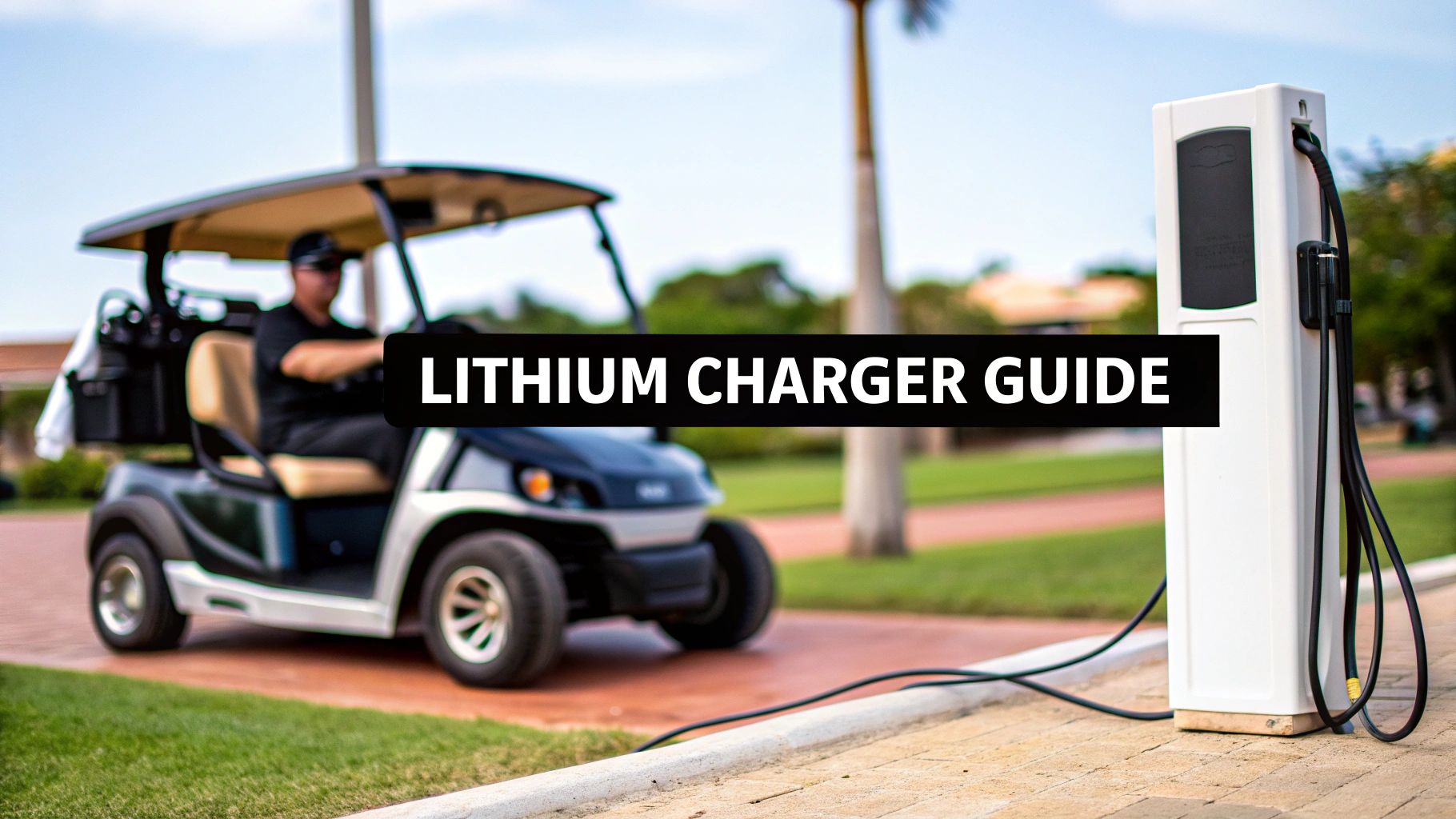Upgrading to lithium batteries is a great first step, but it's only half the battle. To really get the most out of your new setup, you need to pair them with the right lithium battery charger for your golf cart. Think of it like this: you wouldn't plug a brand-new smartphone into a dusty old power brick from a decade ago and expect it to charge quickly or safely. It’s the exact same principle here—the charger is just as critical as the batteries themselves for unlocking speed, safety, and a longer lifespan.
Why Your Golf Cart Needs a Smart Lithium Charger

Making the jump from traditional lead-acid to lithium batteries is a massive upgrade. You get a lighter cart, more power, and zero maintenance. But to tap into what this technology can really do, you need a charger that speaks its language. An old lead-acid charger just can't keep up; in fact, using one is a recipe for poor performance and can even be dangerous.
That's where modern smart chargers come in. They're built specifically for lithium-ion chemistry. They don’t just blindly pump electricity into the battery; they actively communicate with the battery’s built-in protection system, the Battery Management System (BMS). This digital handshake is the secret to getting peak performance and protecting your investment.
The Smart Charging Advantage
This constant communication lets the charger monitor critical data in real-time. So, instead of just dumping a constant current, a smart charger intelligently tweaks its output based on what the BMS is reporting back. It's a precise process that ensures every single cell in the battery pack is charged perfectly and safely.
The results are things you'll notice right away:
- Faster Charging Speeds: Lithium batteries can go from empty to full in as little as 3-5 hours, a huge improvement over the 8-10 hours you're used to with lead-acid.
- Enhanced Battery Lifespan: By preventing overcharging and keeping temperatures in check, a smart charger keeps your battery healthy, giving you more rounds on the course for years to come.
- Superior Safety: The charger and BMS work in tandem to shut down any potential hazards like overheating or short-circuiting. It’s all about peace of mind.
This is a world away from the old brute-force method of charging. It's a smarter, data-driven approach that protects your battery from damage and makes sure it’s ready to deliver consistent power every time you tee off.
A dedicated lithium battery charger isn't just a nice-to-have accessory; it's a fundamental part of the entire power system. It’s what lets the battery live up to its full potential while keeping everything safe and reliable.
The industry is clearly moving in this direction. The global market for lithium golf cart batteries is expected to jump from $708.1 million in 2024 to an estimated $2.5 billion by 2035. That huge growth shows that cart owners everywhere are realizing a complete lithium system—charger included—is the new standard. If you're interested in the numbers, you can find more insights about lithium golf cart battery growth.
How to Choose the Right Charger for Your Cart

Picking the right lithium battery charger for a golf cart can feel like you’re trying to crack a secret code. You’re hit with a wall of numbers, ratings, and plug shapes that don't make much sense at first. But once you know what to look for, you'll be able to read any product label with confidence.
Think of it like choosing the right fuel pump for a high-performance engine. The wrong one won't just underperform; it could cause some serious, expensive damage. Getting this right is key to ensuring your battery charges safely, efficiently, and lasts for years to come.
Match Your Voltage Perfectly
This is the golden rule, the one you can’t bend: your charger's voltage must match your golf cart's battery system voltage. A 48V battery pack needs a 48V charger. A 72V system needs a 72V charger. No exceptions.
Using the wrong voltage is a fast track to destroying your expensive lithium battery and its internal Battery Management System (BMS). It’s a surefire way to cause permanent cell damage, turning your battery into a very expensive paperweight and voiding your warranty. Always, always double-check your cart's battery specs before you even start shopping.
Understand Amperage and Charging Speed
If voltage is the lock, then amperage (Amps) is the key that determines how fast the door opens. Amperage is all about charging speed. It’s like filling a bucket with a water hose—a higher amp rating is like cranking the faucet wide open, filling the bucket (your battery) much faster.
A standard charger might hover around 15-20 amps, which is perfect for a reliable overnight charge. If you want to get back on the course sooner, a higher-amperage model of 25 amps or more will drastically cut down your charging time.
Key Takeaway: Faster is great, but make sure your battery's BMS is rated to handle that speed. Most quality lithium batteries are built for it, but a quick check of your battery’s manual is always a smart move.
Essential Features You Cannot Ignore
Beyond the core specs, a few other features separate a basic charger from a great one. These are the details that protect your investment and just plain make your life easier.
- Automatic Shut-Off: This is a non-negotiable feature for any modern charger. Once the battery is full, the charger stops sending power, preventing overcharging. This "set-it-and-forget-it" ability is what makes smart chargers so safe and convenient.
- IP Rating for Weather Resistance: The IP (Ingress Protection) rating tells you how well the charger is sealed against dust and water. If you have an onboard charger exposed to the elements, look for a rating of IP67. This means it's completely dust-tight and can even handle being submerged in water.
- Correct Plug Type: Golf carts use a surprising variety of plug styles. The most common and frustrating mistake is buying a charger with the wrong connector for your cart's charging port.
Identifying Your Cart's Connector
Before you click "buy," you absolutely need to know which plug your cart uses. The easiest way is to snap a quick photo of the port on your cart and compare it to the charger's plug online. Some of the most common types include:
- Crowfoot: An older, two-pronged, D-shaped plug.
- Anderson: A popular, robust, and often color-coded rectangular connector.
- Club Car 3-Pin: A round connector with three pins, specific to many Club Car models.
- EZGO TXT: A D-shaped plug with two blades, common on EZGO carts.
Making sure you have the right plug from the start saves you the massive headache of returns and hunting for adapters. If you want to see more examples, check out our ultimate guide to the top chargers for electric golf carts. By locking in these details—voltage, amperage, safety features, and plug type—you're ready to choose the perfect charger for your cart.
How Smart Chargers Protect Your Lithium Battery
A high-quality lithium battery charger for a golf cart does a lot more than just pump electricity back into the battery—it’s a dedicated guardian for your investment. Think of it as a sophisticated, ongoing conversation between the charger and your battery's internal brain, the Battery Management System (BMS). This constant digital dialogue is the secret to getting the most life and performance out of your battery.
Unlike an old-school lead-acid charger that just brute-forces a steady stream of power, a smart charger is always asking the BMS for updates. It’s checking on the health of individual cells, keeping an eye on the battery's temperature, and tracking precise voltage levels in real-time. This flow of information lets the charger make intelligent decisions on the fly, protecting your battery from the inside out.
The Three Stages of a Smart Charge
This whole process isn't just a one-size-fits-all power dump. Instead, a smart charger guides your battery through three distinct stages, each one carefully designed for optimal health and efficiency. It’s a bit like a personal trainer who adjusts your workout based on your energy levels—pushing hard when you can handle it and easing off at just the right time.
The charging cycle usually breaks down like this:
- Bulk Stage: This is the heavy-lifting phase. The charger pushes out the maximum current (amperage) to quickly bring the battery up to around 80-90% of its capacity.
- Absorption Stage: Once the battery hits a certain voltage, the charger eases up. It holds the voltage steady while gradually reducing the current, which lets the final cells "absorb" the last bit of power without getting stressed.
- Float Stage (or Cut-Off): For lithium batteries, this isn't about a continuous trickle charge. A true smart charger knows the moment the battery is 100% full and completely shuts off the power. It then just monitors the battery, only kicking back on if the voltage drops after a while. This is crucial for preventing overcharging.
To really get why this matters, it helps to understand the impact of temperature and charging rates on lithium-ion cell degradation. A smart charger is engineered to directly fight against the very things that cause batteries to wear out too soon.
Preventing a Catastrophe: Thermal Runaway
One of the most critical jobs of this charger-BMS partnership is preventing a dangerous situation called thermal runaway. This is what happens when a battery cell overheats, setting off a chain reaction that can cause other cells to fail and, in the worst cases, lead to a fire.
A smart charger is your first line of defense. If the BMS signals that temperatures are getting too high, the charger will immediately cut back on its power output or shut down completely until things are safe again. This active thermal management is something a basic charger just can't do.
This kind of protective tech is becoming more vital every year as lithium batteries take over. North America is leading the charge, expected to make up over 40% of the global market for lithium golf cart batteries in 2025. In the U.S. alone, the electric golf cart market was valued at $546.7 million in 2025 and is projected to hit $886.7 million by 2033. This massive growth is exactly why understanding protective charging technology is so essential for today's cart owners.
At the end of the day, a quality charger is a vital part of the entire power system. This concept applies across all kinds of electric mobility devices, and you can learn more about how these systems work in our complete explainer guide to electric trolley batteries.
Simple Steps for Charger Installation and Setup
Getting your new lithium battery charger for a golf cart up and running is a lot easier than you might think. Whether you've picked up a convenient onboard unit or a flexible portable charger, the basic steps are pretty much the same. The whole point is to create a safe, secure connection that protects your new battery and gets you peak performance from day one.
Think of it like setting up a new TV. You wouldn’t just jam the plug into any old outlet without making sure it's the right one and the cord is secure. We’re applying that same common sense here—a few minutes of careful setup ensures your charger will work flawlessly for years.
Your Pre-Installation Safety Checklist
Before you even think about touching a wire, let’s talk safety. Disconnecting your old system the right way is crucial to prevent sparks, short circuits, or frying your cart's electronics. It’s a simple but non-negotiable first step.
Just run through this quick checklist before you start:
- Switch to Tow Mode: Find the Run/Tow switch on your cart, which is usually tucked away under the seat. Flip it to TOW. This is like a master safety switch that disconnects the motor controller and the main power system.
- Disconnect the Old Battery: Now, carefully disconnect the main negative (-) terminal first, then the main positive (+) terminal from your old battery pack. Doing it in this order is the pro-trick to minimize any chance of accidental sparks.
- Remove the Old Charger: If you're swapping out an old onboard unit, unplug it and unbolt it from the cart’s frame. Keep an eye on the mounting hardware—you might be able to reuse it for the new charger.
With the old system safely out of the picture, you’ve got a clean slate to work with.
This diagram shows how a smart charger and the battery's BMS talk to each other to deliver a safe, precise charge.
This "conversation" between the charger and the BMS is what keeps your expensive new battery healthy and performing at its best.
Securing the New Connections
Alright, time for the main event: installing your new charger. If you've got an onboard model, pick a spot with good airflow to help keep it cool. Use the hardware that came with it to bolt it down securely to the frame so it won’t rattle loose while you’re driving.
For both onboard and portable chargers, the wiring is identical. Connect the charger’s positive (red) lead to the battery’s positive terminal first. Then, connect the negative (black) lead to the negative terminal. Always connect positive first, then negative. Give the connections a little tug to make sure they’re snug. A loose connection can create heat and lead to poor charging.
For a deeper dive into the whole process, including electrical planning, this expert guide to EV charger installation is a fantastic resource.
The Critical First Charge Cycle
That first charge is your chance to make sure everything is working perfectly. Plug the charger into a standard wall outlet, flip your cart’s switch back to RUN, and just watch what happens.
On this first charge, keep an eye on the charger's indicator lights. You should see them cycle through the different charging stages and, finally, signal a full charge before the unit shuts off automatically. This is your confirmation that the smart charging feature is doing its job.
Listen for any weird buzzing or humming sounds, and feel the charger to make sure it isn’t getting overly hot—a little warmth is totally normal. Once it shows a full charge, your installation is officially complete.
To learn more, check out our golf cart battery charging tips for max longevity. Following these simple steps will set your new lithium power system up for success, giving you reliable power for countless rounds to come.
Onboard vs. Portable Lithium Chargers: Which is Right for You?
When you make the jump to a lithium battery charger for your golf cart, one of the first decisions you'll face is whether to go with an onboard or a portable model. This isn't just about personal preference; it’s about choosing a setup that actually fits your lifestyle, how you use your cart, and where you keep it.
Each style brings something different to the table, so let's break down what makes them tick.
An onboard charger is all about convenience. It’s permanently installed right on the cart, which means it’s always ready to go when you are. You never have to worry about forgetting it in the garage or trying to find where you left it. After a round, just pull up near an outlet, plug in an extension cord, and you're done. It’s the ultimate "set-it-and-forget-it" solution.
On the flip side, a portable charger delivers total flexibility. These chargers are small, light, and can easily be tucked away in a garage cabinet or even your cart's glove box. If you have a vacation home or like to take your cart with you on trips, a portable charger is a no-brainer. You can power up anywhere you can find a standard wall outlet.
Convenience and Installation
The real beauty of an onboard charger is its seamless integration. Once it’s bolted down and wired into your battery system, you never have to mess with it again. This setup is perfect for anyone who uses their cart daily around their home course or community and wants charging to be as effortless as possible.
Portable chargers, however, are king when it comes to simplicity. There's zero installation required. You just connect the clamps or plug to your battery, plug the other end into the wall, and you're charging. It's a great option for folks who aren't comfortable with permanent wiring or want the ability to easily swap out their charger down the road. Plus, their small size means they won't clutter up your garage.
The worldwide move toward electric power is really pushing charger technology forward. In Europe, for example, strict environmental regulations are accelerating the switch to lithium. Chargers over there often need to meet tough efficiency standards, like the EU Ecodesign Directive, which limits how much power they can use in standby mode. This is good news for everyone, as it's driving manufacturers to create smarter, more energy-efficient chargers for all kinds of electric vehicles, including our golf carts. You can read more about what's happening in the European golf cart battery market.
Onboard vs Portable Charger Feature Comparison
Choosing between an onboard and a portable charger really comes down to what you value more: set-it-and-forget-it convenience or grab-and-go flexibility. This table breaks down the key differences to help you decide which one is the best fit for your routine.
| Feature | Onboard Charger | Portable Charger |
|---|---|---|
| Installation | Permanent; requires wiring into the cart's system. | None; plug-and-play operation. |
| Convenience | Always on the cart, ready to use. | Must be carried separately. |
| Best For | Daily use at home or in a single location. | Multiple locations, travel, or occasional use. |
| Weather Resistance | High (often IP67 rated); sealed against dust/water. | Low; must be used in a dry, protected area. |
| Storage | Takes up no extra space. | Requires storage space in a garage or shed. |
| Flexibility | Limited to the cart it's installed on. | Can be used with different carts (with compatible plugs). |
| Replacement | More involved to replace. | Very easy to replace if needed. |
Ultimately, if your cart lives in one place and you want charging to be as simple as plugging in a cord, an onboard charger is your best bet. But if you need the freedom to charge in different locations or want to avoid any installation, a portable charger offers unbeatable flexibility.
Weather Protection and Durability
Onboard chargers are built to take a beating. Since they live on the cart and are exposed to the elements, they usually come with a high IP (Ingress Protection) rating, often IP67. This means they're completely sealed against dust and can handle being submerged in water. This rugged design ensures they'll keep working through rain, splashes from washing your cart, and humid mornings.
Portable chargers are a different story. They aren't designed to be weatherproof and need to be used in a dry, sheltered spot like a garage. While that might sound like a negative, it also means they’re shielded from the constant wear and tear of being outdoors. If you take care of it, a portable charger can have a very long life. The trick is simply remembering to keep it indoors, away from moisture.
Frequently Asked Questions
When you're thinking about upgrading your cart’s power system, a few last-minute questions always pop up. Getting straight answers is the best way to feel good about your investment in a lithium battery charger for a golf cart. This section tackles the most common things we hear from owners making the switch.
Our goal is to clear up any final doubts so you can move forward, confident you’ve made the right call for your cart's performance and future. Let’s get into it.
Can I Use My Old Lead-Acid Charger on a Lithium Battery?
This is probably the most important question we get, and the answer is a hard no. Trying to use your old lead-acid charger on a new lithium battery is a recipe for disaster, and it's not worth the risk.
The charging profiles for these two battery types are completely different. A lead-acid charger sends power in a way that will permanently damage the sensitive cells in a lithium battery. It won't just ruin your new battery and void the warranty instantly—it's a serious safety hazard. You absolutely have to use a charger built specifically for your battery's lithium chemistry and voltage.
How Long Does It Take to Charge a Lithium Golf Cart Battery?
One of the best perks of going lithium is how much faster you’ll get back on the course. While the exact time depends on your battery's capacity (Ah) and the charger's amperage, the difference is night and day.
Most standard lithium golf cart batteries will go from empty to full in just 3 to 5 hours. Compare that to the 8 to 10 hours you’d typically wait for a traditional lead-acid battery to finish, and you can see why it’s such a game-changer.
The ability to leave a smart charger plugged in is one of its core safety features. Unlike older "trickle chargers" that could potentially overcharge a battery if left unattended, a modern lithium charger is designed to completely stop charging once the battery is full. It’s true "set-it-and-forget-it" technology.
Is It Safe to Leave the Lithium Charger Plugged In?
Yep, it’s perfectly safe. Modern smart chargers are designed with exactly this in mind. They have an automatic shut-off feature that cuts all power the moment your battery's management system (BMS) signals that it's fully charged.
Once it shuts off, the charger just hangs out in a standby mode. This eliminates any risk of overcharging, which protects your battery’s long-term health and makes sure your cart is always topped off and ready to go.
What Does a Charger's IP Rating Mean?
The IP (Ingress Protection) rating is just a simple, universal code that tells you how well a charger’s case is sealed against stuff like dust and water. It’s made up of two numbers.
For example, an IP67 rating is fantastic for an onboard charger. The first number, "6," means it's completely sealed against dust. The second number, "7," means you could even temporarily drop it in water without causing damage. For a charger that lives on your cart, that level of protection from rain, washing, and humidity is a must-have feature.
Ready to upgrade your golf cart experience with effortless power and reliability? Caddie Wheel offers a seamless, powerful electric assist system that lets you walk the course without the strain. Explore the Caddie Wheel and transform your game today!


Share:
Your Guide to the Modern Golf Power Cart
Your Guide to Replacement Lithium Battery Success